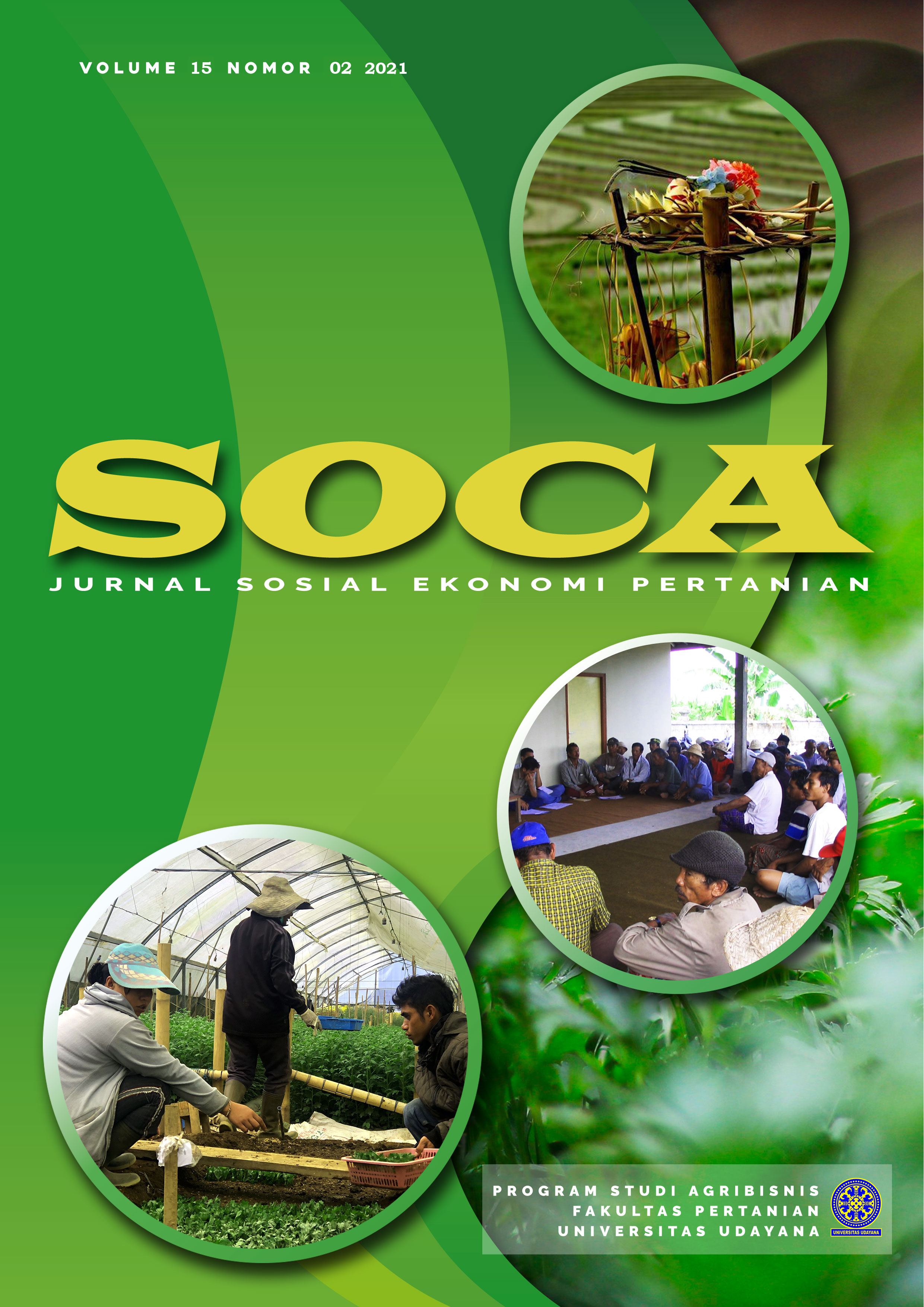The Observation of Blast Disease and Its Effect to Rice Yield Using Existing Assessment Method to Support the Indonesian Agriculture Insurance
Abstract
One of the causes for the low productivity of rice in Indonesia is the occurrence of rice blast disease. Blast disease is one of the main diseases of rice plants around the world. Therefore to minimise the risk of the lost yield by blast disease, the Ministry of Agriculture of the Republic of Indonesia has the agriculture insurance program. To support these program, the research about observations of blast disease in a fixed location are needed. The objective this research is to confirm pathogens causing the blast disease in the fields, to determine the development of blast disease and its effect to the rice yield (grain weight and straw weight). The study was conducted in a fixed paddy field at Subak Uma Dalem, Sobangan Village, Mengwi District, Badung Regency, Bali Province from February 2019 to April 2019. The data showed that the disease incidence of rice blast increased every week starting from 1st week (28 DAT) until 10th week (104 ATP). Our study confirmed that the fungus caused the blast disease in the field was Magnaporthe oryzae. The higher incidence of blast disease in the field resulted reduced the rice yield by decreasing both grain and straw weights.
Downloads
References
Giamerti, Y., Hongo, C., Saito D., Caasi ,O., Susilawati, P. N., Shishido, M., Sudiarta, I P., Wijaya I M. A. S., Homma, K. (2021). Evaluating Multispectral Imaging for Assessing Bacterial Leaf Blight Damage in Indonesian Agricultural Insurance. E3S Web of Conferences 232, 03008, 1-7.
Harmon, P. F., Dunkle, L. D. and Latin, R. (2003). A rapid PCR-based method for the detection of Magnaporthe oryzae from infected perennial ryegrass. Plant Disease 2003 (87), 9 1072-1076
Kementrian Pertanian. (2018). Petunjuk Teknis Pengamatan dan Pelaporan Organisme Pengganggu Tumbuhan dan Dampak Perubahan Iklim (OPT-DPI). Direktorat Perlindungan Tanaman Pangan. Jakarta.
Ministry of Agriculture of The Republic of Indonesia. (2021). Rice Farming Business Insurance, Harvest Failure Solution.
https://www.pertanian.go.id/home/?show=news&act=view&id=1609. Diakses pada tangal 27 Februari 202.
Ministry of Agriculture of The Republic of Indonesia. (2019). Agricultural Insurance for the Protection of Farmers' Business.
https://www.pertanian.go.id/home/?show=news&act=view&id=3668. Diakses pada tanggal 27 Februari 2021.
Rahardjo, I. B. dan Suhardi. (2008). Insidensi dan Intensitas Serangan Penyakit Karat Putih pada Beberapa Klon Krissan. Hort. 18(3), 312-318
Riana, E. (2011). Seleksi Dan Formulasi Konsorsium Bakteri Untuk Mengendalikan Penyakit Blas (Pyricularia Oryzae) Pada Tanaman Padi, https://docplayer.info/53847227-Seleksi-dan-formulasi-konsorsium-bakteri-untuk-mengendalikan-penyakit-blas-pyricularia-oryzae-pada-tanaman-padi-eko-riana.html. Diakses pada tanggal 27 Februari 202.
Semangun, H. (2008). Penyakit-Penyakit Tanaman Pangan di Indonesia (EdisiKedua).Yogyakarta: Gadjah Mada University Press.
Surning, NI N., Ambarawati, I G. A. A., Ustriyana, I N. G.. (2018). Willingness To Pay Petani terhadap Pelaksanaan Asuransi Usaha Tani Padi (AUTP) (Studi Kasus Subak Cepik Desa Tajen Kecamatan Penebel Kabupaten Tabanan). E-Jurnal Agribisnis dan Agrowisata 7(3), 364-373.
Wang, X., Lee, S., Wang, J., Ma, J., Bianco, T. and Jia, Y. (2014). Current advances on genetic resistance to rice blast disease. Chapter 7 in Rice-Germplam, Genetics and Improvement (W Yan and J Bao, eds.). Available online at: http://www. intechopen.com/books/ricegermplasmgeneticsandimproveme nt/current-adva nces-on-genetic-resistance-torice-blast-disease. Diakses 17 Oktober 2018. https://www.intechopen.com/books/rice-germplasm-genetics-and-improvement/current-advances-on-genetic-resistance-to-rice-blast-disease
Wicaksono, D., Wibowo, A. dan Widiastuti, A. (2017). Metode Isolasi Pyricularia Oryzae Penyebab Penyakit Blas Padi. https://media.neliti.com/media/publications /79836-ID-none.pdf. Diakses pada tanggal 5 Agustus 2019.
Widyantoro, Pane, H., dan Jtmiko, S.Y. (2007). Peningkatan Produksi Padi Gogo Melalui Pendekatan Model Pengolahan Tanaman Terpadu. http://www.litbang.pertanian.go.id/special/padi/bbpadi_2008_p2bn1_19.pdf. 265-282.
Widiarta, IN. dan Suharto, H. (2009). Pengendalian Hama dan Penyakit Tanaman Padi secara terpadu.
http://www.litbang.pertanian.go.id/special/padi/bbpadi_2009_itkp_17.pdf. 469.
Yudarwati, R., Hongo C., Sigit G., Barus B. and Utoyo B. (2020). Bacterial Leaf Blight Detection in Rice Crops Using Ground-Based Spectroradiometer Data and Multi-temporal Satellites Images. Journal of Agricultural Science 12(2), 38-49













